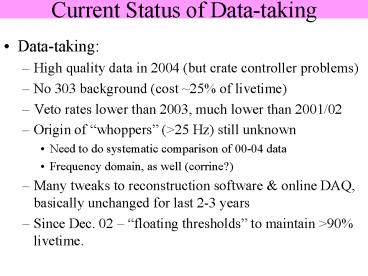Current Status of Datataking PowerPoint PPT Presentation
1 / 24
Title: Current Status of Datataking
1
Current Status of Data-taking
- Data-taking
- High quality data in 2004 (but crate controller
problems) - No 303 background (cost 25 of livetime)
- Veto rates lower than 2003, much lower than
2001/02 - Origin of whoppers (gt25 Hz) still unknown
- Need to do systematic comparison of 00-04 data
- Frequency domain, as well (corrine?)
- Many tweaks to reconstruction software online
DAQ, basically unchanged for last 2-3 years - Since Dec. 02 floating thresholds to maintain
gt90 livetime.
2
HSV board
EVALUATE singles rates for planned RICE-II,
also Fast (1 us) vertex estimation rejection of
anthropogenic noise. Installed Dec.03.
3
Hot channel singles rates
Singles Rate (11 MHz)
2004 Julian Day
4
Data Analysis
- Plan to update ICRC03 result with 2003 data
(analyzed through Oct. 03) 2004 data - Micro-BH analysis close to done
- Parallel GRB analyses on 2002 data (Canterbury)
and 2003 data (KU) - Needs a lot of work
- Air shower analysis
- DZB modeling of muon brems?expect NO 4-hit
coincidences in our data (1 1-hit evt/yr w/
SN11) - May pull out using coincidences with SPASE
(unlikely) - Signal due to air showers stopping at surface
5
Event Recon Efficiency Evaluation
- Philosophy Make kinematic cuts first, then do
waveform correlation last matched filter based
on a) Tx?Rx events, b) radiomc, c) thermal hits
6
www.lns.cornell.edu/dzb/tem/rice03prd.ps
7
Shower Modeling
- Much work done on re-evaluating Veff with correct
ray tracinggtexpect 25 loss of Veff - Developed a neutrino generator (pre-ANIS) now in
process of implementing ANIS to compare - Verify hadronic showerEM shower _at_Egt1 PeV
8
Old vs. New Veff (/2pi illumination)
Upshot corrected ray tracing costs 30 in Veff
9
Politics, politics, politics
- NSF supporting
- Development of RICE-II antennas
- Based on LABRADOR chip (infinitegoogle thanks to
Peter and Gary) - Board layout done, being populated
- Can fit in either dry r6cm hole or IceCube
borehole - All revved up with nowhere to go need a
separate, dedicated proposal to support
hole-drilling (glaciology proposal submitted to
NSF in June04 if funded, use holes for acoustic
detectors as well)
10
Schematic Diagram Cluster Electronics
http//www.people.ku.edu/jledford/Rice2_Files/Doc
uments/RICE_DAQ2_Spec_9_13_04.pdf
11
RICE2 DAQ board (Oct 9, 2004)
12
05-06
- Plan to bring antenna cluster to pole, deploy,
take data and correlate with info from existing
array. - Received transmitter times reasonable?
- Alternately, take two clusters to pole, and run
independently pulse from surface or in borehole - (will need to excavate boreholes in any case).
13
Radioglaciology plans
- ?NSF radioglaciology at Taylor Dome AND S.P
- 3 Boreholes to be drilled _at_each site, baseline 1
km, to 300 m, horizontal broadcasting - Birefringence
- Attenuation length(Temp)
- n(z)
- Layer studies
- Acoustic tests ancillary science (retain cores)
- Vostok mentioned (CRDF now funded)
- Overlap with UCLA ground calibration objectives
14
Scattering off internal layers?
- Internal layers due to seasonal (yearly
crusting) or sporadic (volcanic deposition of
salts, e.g.) - In principle, scattering effects greatest at
glancing angles (Fresnel coefficients
cos(theta)?0 in following plots) - Might guess that, if lambdagtgttlayer, scattering
effects small (DS) - Have compared model (just using Fresnel),
assuming dn0.001 every meter, with data.
15
Layer study (MC)
Vertical distance b/w Rx/Tx2m
16
Data (02-03, 1 ns signal?Tx)
17
Attenuation length measurements
18
Summary of Deployment Options
- Co-Deployment with acoustic modules in IceCube,
06-07 - Wal-Mart ANITA elevated CCCP balloon at Vostok
(CRDF proposal w/ Zheleznykh) - Partial deployment in dry holes to-be-drilled for
SP-component of radioglaciology proposal - Dedicated dry holes (proposal due June 05),
beginning 06-07
19
BIG open questions with RICE-II
- How reliable is optical fiber (single-mode) and
what is past AMANDA experience (infant mortality,
or progressive)? - Albrecht 5-10 failure rate
- Improve with better jacketing/reinforcement?
- Can we achieve ns-timing?
- Clock synchronization from central clock on
surface requires minimization of timing jitter - OTDR transmitter calibrations, on-line
- To what extent can we use/share ICE3/acoustic
software? - Where do we put it?
20
Pre-results / over-optimistic BH model
21
Low Veto Rates (1st half 2003)
22
HSV vs. old RICE DAQ
Green Number of HSV vetoes per 100 minutes Red
veto rate inferred from hits files (scale
arbitrary)
23
The POWER of the HSV
- Began looking at HSV output in detail c. 3/15
- Qual/Quantitatively, find
- Using ability of HSV to duplicate functionality
of MALU/4-hit coincidence trigger find gt99
overlap in identified triggers b/w HSV vs. MALU - On occasion, some channels are running at gt1 Mhz
- See (as expected) correlations between singles
rates (50 of time, see correlated
increase/decrease of singles rates) - Inserted and began testing veto patterns
simultaneous with failure of TDC (unfortunately)
24
Plans for Pole, 04-05, and beyond
- 04-05 Repair DAQ (failed TDC), so can get
meaningful info from HSV module - Do dry run of shallow Tx-in-borehole transmission
to above-surface Rx P(Rx) as f(zTx, zRx, rTx,Rx) - Had hoped for help from Amy C looking unlikely.
- Probe surface effects, verify density contrast at
surface. - Try to understand sigshape diffs (Steve B, DZB)
- 1ns duration signal shapes relatively constant as
f(z(Tx)) - Longer-duration (100 ns) signal shapes show
significant changes as f(z(Tx)) (leading edges
qualitatively more similar) - Multi-path effects

